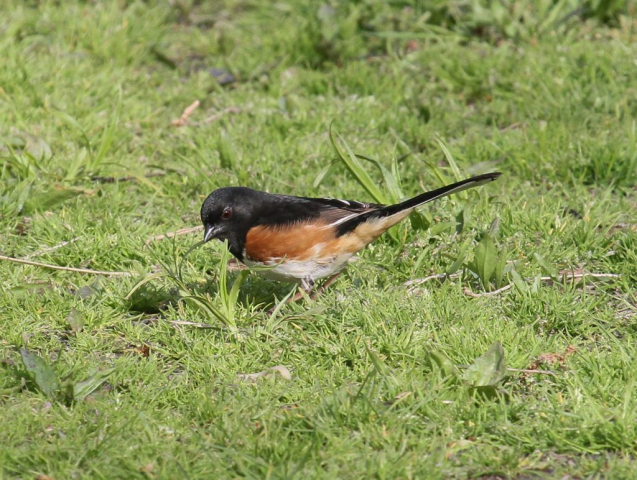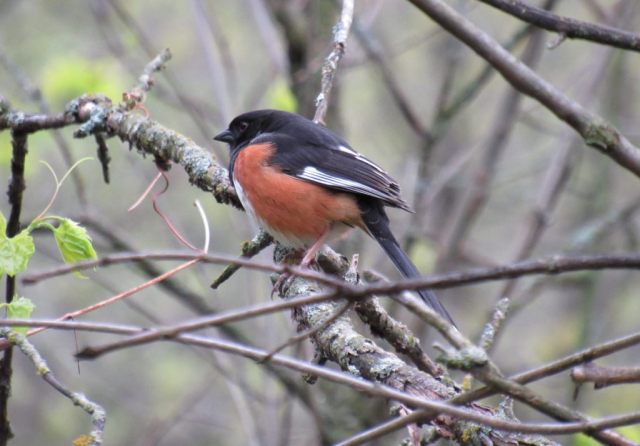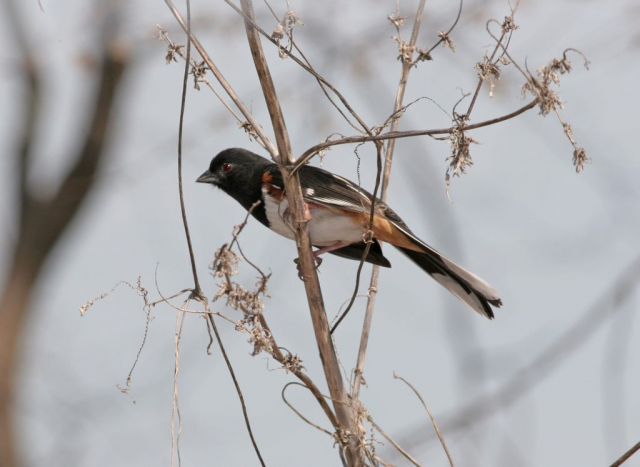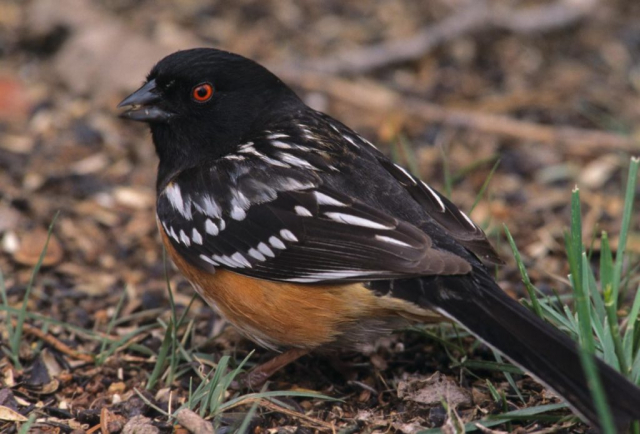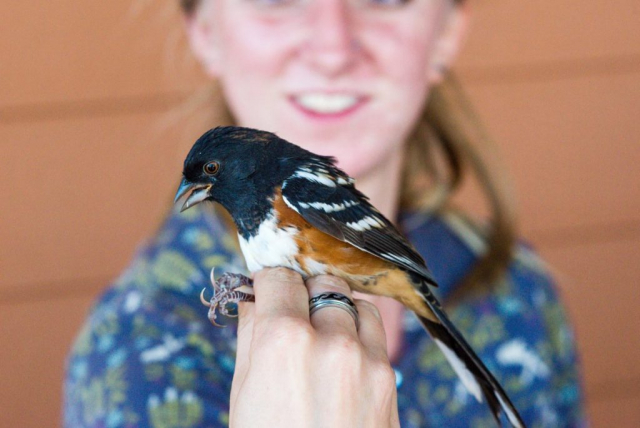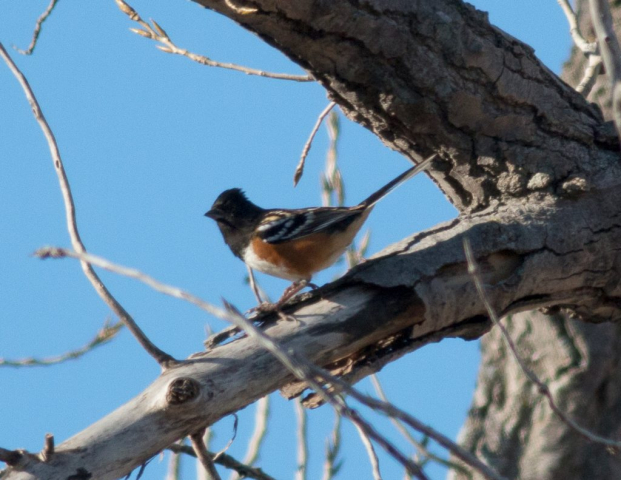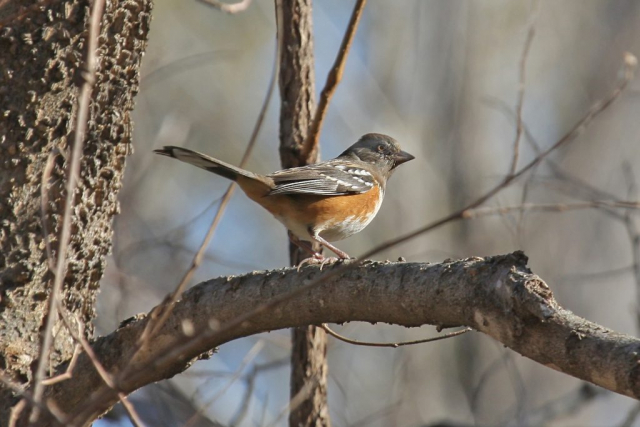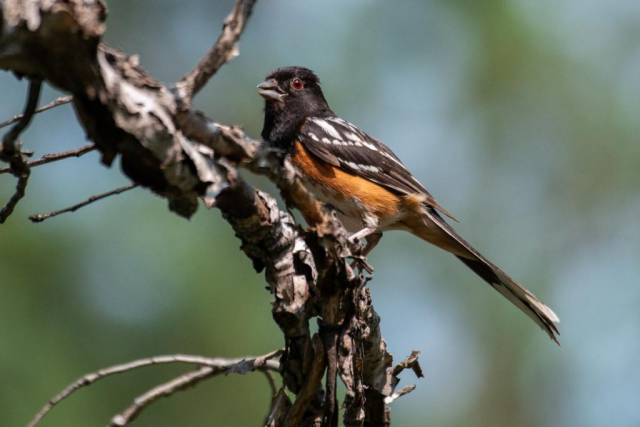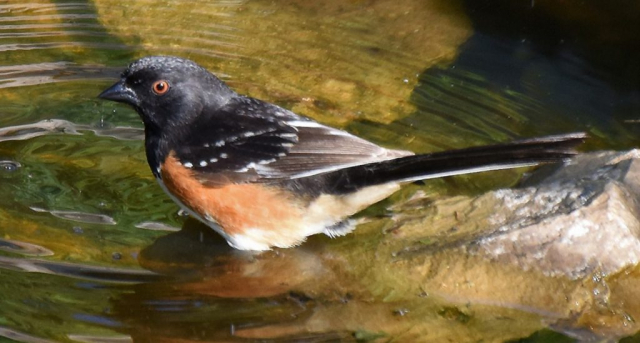W. Ross Silcock | silcock@rosssilcock.com | 17 July 2019, updated 20 April 2020
Spotted and Eastern Towhees are currently considered separate species (Banks et al 1995). Strong genetic differences between Eastern and Spotted Towhees, including absence of shared haplotypes, were demonstrated by Ball and Avise (1992), although, since their samples were from western and eastern extremes (Washington, South Carolina, and Georgia) of the North American range, this result was not unexpected. Re-evaluation of data in Sibley and West (1959) that showed 56% of individuals in the “hybrid zone” were presumed phenotypic Eastern and Spotted Towhees was considered indicative of assortative mating and supported species status (Banks et al 1995). The status of Pipilo towhees in Nebraska was summarized by Bartos Smith and Greenlaw (2020) and Greenlaw (2020).
Greenlaw (2020) indicated in his Figure 2 that essentially all “black” (Spotted and Eastern) Pipilo towhees in Nebraska are introgressants, and that, within the “hybrid zone” (most of the state), Spotted Towhee genes predominate in the Panhandle, the northwestern Loup drainage, and along the northern edge of the state following the Niobrara River Valley and Missouri River Valley east to the Yankton area, while Eastern Towhee genes predominate elsewhere, particularly westward in the Platte River Valley to Garden Co. Thus, according to Bartos Smith and Greenlaw (2020), genotypic Spotted Towhees probably occur only in the Panhandle and genotypic Eastern Towhees only in the extreme east. Nevertheless, there is no genetic evidence that supports the existence 0f hybridization/introgression of the two species, even though it is widely assumed to occur based on phenotypic variation. Given that the two species have no shared haplotypes (Ball and Avise 1992), it might be expected that instead of widespread introgression, a low level of introgression might actually be the case, supported by strong assortative mating, as indicated by the work of Sibley and West (1959), which was in large part the basis for separation of former Rufous-sided Towhee into Spotted and Eastern Towhees (Banks et al 1995).
Sibley and West (1959) suggested that a possible factor leading to assortative mating might be correlation of degree of back spotting pattern with climatic differences, in particular the amount of shade in towhee habitat (more in eastern forests than in western open brush). Anecdotal information supporting this theory was provided by T. J. Walker (personal communication), who observed that in his southeastern Lincoln County survey area “I have noted for years that the [Spotted Towhee] songs vary quite a bit – in areas with more deciduous woodland and cedar coverage most of the songs, while still typical of Spotted, have a little hint of “Eastern” to them. In the areas of the canyons with very little woodland, where the landscape is mostly grassland with shrub thickets the songs are quite “dry” and clearly Spotted.” It follows that if there is a high level of assortative mating between Eastern and Spotted Towhees in Nebraska, a large part of the range of variation in degree of back spotting across the state might be assignable to clinal environmental adaptation, per Sibley and West (1959). Songs, of course, are learned in these two species, not inherited (innate), presumably and would also occur across the state on a variable and clinal basis.
Recommendations to Observers
For a detailed discussion, including the terms “spotted-backed” and “dark-backed” towhees, see the species accounts for Spotted and Eastern Towhees in Birds of Nebraska- Online (www.birdsofnebraska.org).
Since many readers of Birds of Nebraska- Online (www.birdsofnebraska.org) are eBirders as well, the above outline regarding Eastern and Spotted Towhees (EATO, SPTO) in Nebraska should be kept in mind when reporting these species to eBird. Currently, eBird offers four options for submitting checklists: Spotted X Eastern Towhee (presumably F1 hybrids), Spotted/Eastern Towhee (introgressants, many”spotted-backed” towhees), Spotted Towhee, and Eastern Towhee. Our Nebraska eBird reviewers set their filters to zero for several regions and seasons, which requires observers to provide documentation. For example, reporting an Eastern Towhee in the Panhandle will flag and the reviewer will request further details. In general, however, these are the guidelines that reviewers follow:
Spotted Towhee X Eastern Towhee: This option should be avoided and deleted from all filters, since it refers to first generation (F1) crosses, which would be extremely rare and, in any case undocumentable in Nebraska given the plethora of introgressants.
Towhee/Eastern Towhee: This category is for “spotted-backed” towhees that appear to be less than “pure” Spotted Towhees or for “dark-backed” towhees that show a few spots. Except for regions where Spotted Towhee and Eastern Towhee are expected (extreme northwest and southeast, see below), and unless documented as Spotted Towhee or Eastern Towhee, all eBird reports should be in this category.
Eastern Towhee or Spotted Towhee: Although at certain seasons and regions determined by reviewers, reporting towhees as species will not flag, the vast majority of Nebraska towhees, especially in central Nebraska in summer, should be reported as “Eastern Towhee/Spotted Towhee” unless a particular bird can be documented (photo, recording, description) as Eastern Towhee or Spotted Towhee.
Figures 1 and 2 below show the ranges of each species, with an overlay indicating distributions of phenoptypes across the state.
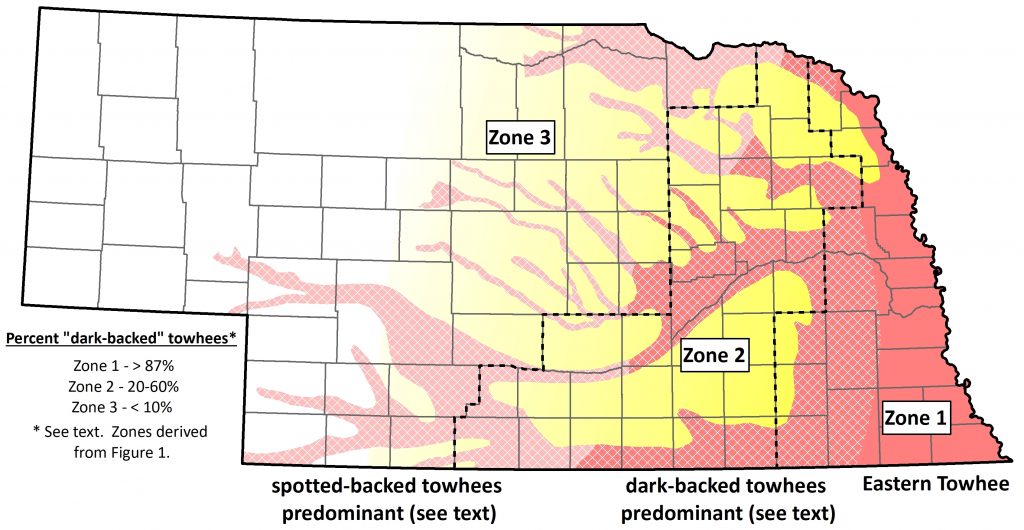
Figure 1. Eastern Towhee range in Nebraska.
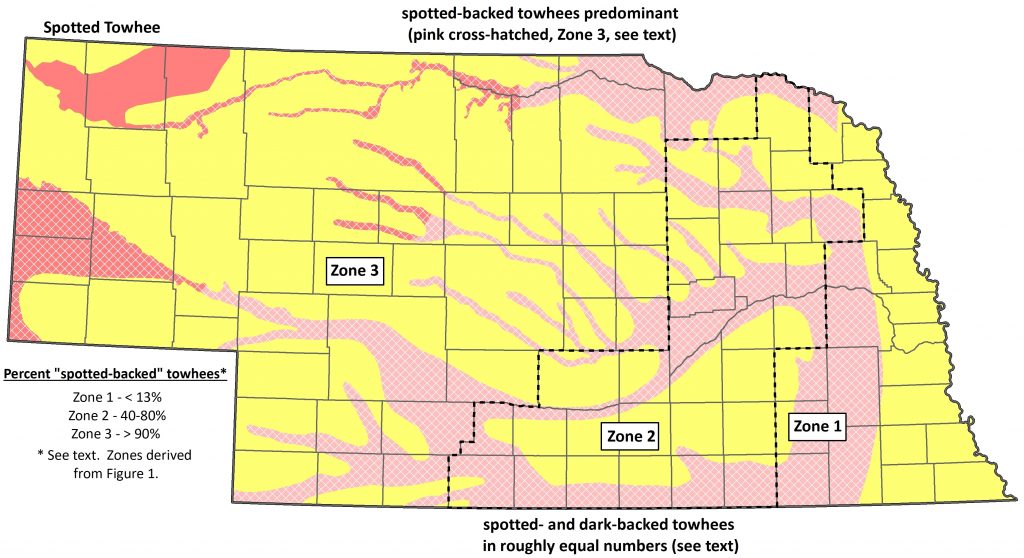
Figure 2. Spotted Towhee range in Nebraska.
Literature Cited
Ball, R.M. Jr., and J.C. Avise. 1992. Mitochondrial DNA phylogeographic differentiation among avian populations and the evolutionary significance of subspecies. Auk 109: 626-636.
Banks, R.C., J.W. Fitzpatrick, T.R. Howell, N.K. Johnson, B.L. Monroe Jr., H. Ouellet, J.V. Remsen Jr., and R.W. Storer. 1995. Fortieth supplement to the American Ornithologists’ Union Check-list of North American Birds. Auk 112: 819-830.
Bartos Smith, S., and J.S. Greenlaw. 2015. Spotted Towhee (Pipilo maculatus), version 2.0. In The Birds of North America (P. G. Rodewald, Editor). Cornell Lab of Ornithology, Ithaca, New York, USA. https://doi.org/10.2173/bna.263.
Brown, C.R., and M.B. Brown. 2001. Birds of the Cedar Point Biological Station. Occasional Papers of the Cedar Point Biological Station, No. 1.
Fresard, L., M. Morisson, J.-M. Brun, A. Collin, B. Pain, F. Minvielle, and F. Pitel. 2013. Epigenetics and phenotypic variability: some interesting insights from birds. Genetics Selection Evolution 45:16.
Greenlaw, J.S. (2015). Eastern Towhee (Pipilo erythrophthalmus), version 2.0. In The Birds of North America (P. G. Rodewald, Editor). Cornell Lab of Ornithology, Ithaca, NY, USA. https://doi.org/10.2173/bna.262.
Knopf, F.L. 1986. Changing landscapes and the cosmopolitanism of the eastern Colorado avifauna. Wildlife Society Bulletin 108- 132-142.
Scharf, W.C. 2005. New westward breeding records for Eastern Towhees in Central Nebraska. NBR 73: 26-28.
Short, L.L., Jr. 1961. Notes on bird distribution in the central Plains. NBR 29: 2-22.
Sibley, C.G., and D.A. West. 1959. Hybridization in the Rufous-sided Towhees of the Great Plains. Auk 76: 326-328.
Williams, G. P. (1978). The case of the shrinking channels: The North Platte and Platte Rivers in Nebraska (Vol. 781). Department of the Interior, Geological Survey.
